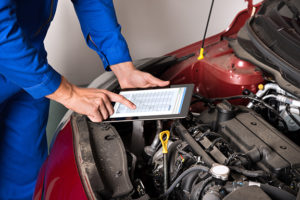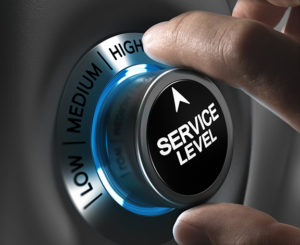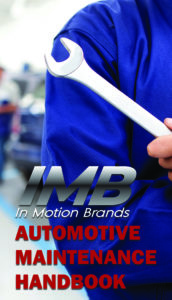Auto Repair Shop Operations Manual

Free Automotive Shop Improvement Playbook
Over the coming decade, auto repair shops will need to dramatically increase the aftermarket industry average net income to sales ratios. This will be required to be able to make the necessary investments in the business. IMB’s Auto Repair Shop Operations Manual was created to provide a clear path on how to drive your automotive business by improving customer service and experience.
Over the last decade, we have spent time collecting performance data across multiple locations, markets, and segments of the aftermarket automotive industry. What we have found, consistently, is that there are generally six figures of opportunity available with each aftermarket automotive business as the business exists today. We have created a playbook for you to take advantage of this opportunity.
In our Auto Repair Shop Operations Manual, you can find an eight-step detailed outline for how to handle every step in the customer service journey. If followed, your clients will receive industry leading customer service and your business will reach much sought after industry performance every time, with every client. This is not a statement, but a fact, based on the performance of many aftermarket automotive businesses.
The eight-step detailed outline in our Auto Repair Shop Operations Manual covers some of the highlighted areas below and more.
1) Initial contact (phone call)

2) Before the client arrives
Once the appointment is booked, there is preparation and planning involved from the Service Advisor to ensure a smooth consistent customer service experience. We need to think about what is happening within the management system. Exactly what are we reviewing or researching? Our work order needs to be completely transparent and include a sales dollar amount for work we know we are going to do. We also want to have sales amounts for the work we think we may have to do.
3) The client’s arrival
Here we are reviewing, advising, and seeking approvals of the preparation work we have completed. We are both intentional and strategic upon client arrival. We are crystal clear on how and what we are communicating. We gain approvals to allow us and the client to be productive and efficient with time use.

4) Technician process
To keep productivity up we recommend following a consistent flow with the back shop. We need to have continuity in what happens not only first, but with what happens every time. We need a plan followed for when the back shop engages with the front shop or vice versa. In doing, so communication is improved, trust is increased, and productivity is increased.
5) Consultation process
To improve shop management, we drill into preparing the estimate, presenting the estimate, receiving approvals, and confirming commitments. How are we engaging with clients strategically? When we do engage the client, what are we leading with first, every time? How do we increase the closing rates in our communications with our clients?
6) Preparation for vehicle delivery
We could call this area of the standard operating procedures “quality control with a wow factor”. Here we ensure we have gone above and beyond the customer service experience. How many times should the client’s vehicle been in and out of our shop by now? What have we done to put a smile on the face of the client with service process improvements? Above customer service, what gold nuggets have we harvested to raise the experience to levels outside of our industry by true experience leaders? Are we even aware of the difference between customer service and customer experience?
7) Delivery of the vehicle
This is where we are really setting ourselves up for future success and setting the bar for customer service. The level of detail we should be giving around the work performed is often overlooked by the Service Advisor’s. Not only do we need to communicate the work performed, the benefits, and the warranties but we also need to increase confidence. If we have improved customer service levels to wow and harvested gold nuggets to improve customer experience, do we communicate this to the client?

8) Post service follow up
Quick touch points provided to ensure client satisfaction and gain some digital equity for your business. So many have an informal “no follow up” policy but do they ever pay dividends? This is not a technical requirement to be able to follow up so much as a soft skill. It does not take much time but is very effective on a number of fronts. Simple follow up processes can gain additional sales all the way to ensure higher levels of client satisfaction. How can we implement something simple and strategic that increases our business additional relevance?
Additionally, in our Auto Repair Shop Operations Manual, we give you two check lists or flow charts for initial client concerns. These checklists will help both owners and technicians ensure the proper information is gathered to run a smooth operation.
The first check list covers symptoms commonly communicated for a car repair. These include:
- Lights on or flashing on dash
- Will not start
- Will not crank
- Slow to crank
- Will not move
- Engine revving high
- Hard shifts
The second check list covers noise & vibration concerns such as:
- Bump
- Rattle
- Boom
- Whine
- Clunk
- Squeak
- Growl
- Vibration
For each common symptom or concern, we provide a few questions for each listed symptom to start to drive a more profitable shop. The questions provided narrow the concern by drilling into further detail about lights on, frequency, when, speed, location etc. By increasing the level of detail, we provide the necessary communication between the client to the technician. We also have the invoice prepared correctly to improve customer service and operate a more profitable shop. This is an incredible resource to build confidence with members on the team who are not always up front or are new to the position when fielding these client contacts. Employees leave and having resources to help get the right team addition “up the curve” is essential, of which IMB has plenty.
IMB is providing Shop Owners our Auto Repair Shop Operations Manual free with no strings. We have created this as a way that offers a checklist for a Shop Owner to evaluate their current process at each step of the client interaction. We feel this information should be readily available for all shop owners in the aftermarket automotive businesses. Strong operating procedures are necessary to help drive the performance required over the next decade. Competitive pressures such as e-commerce, staffing, and increased operating expenses continue to increase. On top of these competitive pressures, we also have a significant shift in market trends and consumer behavior unfolding that we need to stay ahead of.
We were all told over ten years ago we must stop operating as if we are car repair or automotive repair shops. Many have still not made the shift to balance their businesses with a more increased labour focus. We were able, for the most part, to do well over the last decade as the economy thrived. With the competitive pressures of the business, along with trends in the market, we must ensure we are doing all things well over the coming decade or many will not be as fortunate as they have been over the last decades. Our Auto Repair Shop Operations Manual was created to help you as a free management resource.
Please note depending on where you are today, our Auto Repair Shop Operations Manual may seem overwhelming at first glance. Read our thoughts and consider your current standard operating procedures. Next, think about how your shop management flow could be improved with respect to customer service and performance. How does it compare to the management resources you have today? Are you and your team checking all the boxes with every interaction to focus on labour? Does your current management system allow you to?
Start by taking pieces you, as the Shop Owner, feel will have the biggest impact to implement first. As we all know, changes to improve shop management with improving standard operating procedures requires clear and consistent communication. Once your team is aware and understands the expectations, it is easier for them to predict, or engage. Giving your team a playbook to follow will further both their development and your shop performance.

If meeting with an industry expert is not appealing, we would also be happy to connect you with our clients who operate aftermarket automotive businesses themselves. IMB is building a network of industry leading businesses in our space. The business owners we are partnering with are just as impressive as any industry expert and live the same challenges you do.
If you take the time to review our Auto Repair Shop Operations Manual, we would be happy to have your feedback. We would not bet that every Shop Owner would agree with each key area in the sequence laid out, but we would bet there is free value created for your business by reviewing. At IMB, we are always open to constructive fresh ideas and love talking aftermarket automotive business excellence.
We are well aware the market is shifting immensely, the cost to operate is increasing, and the investment required not only in technology, but people is also increasing. Shop Owners will need cash on hand to be relevant as we move through the next five to ten years. The most ironic thing about the automotive aftermarket is the more money you have in the bank, the more clients you have helped in a deep meaningful way. To achieve the much sought-after industry leading shop performance, it quite often comes down to Shop Owner’s overcoming the biggest hurdle each face. You know who this is.
Please have a look, let us know your feedback, and thank you for your time.
To request your free download, submit your information below!
